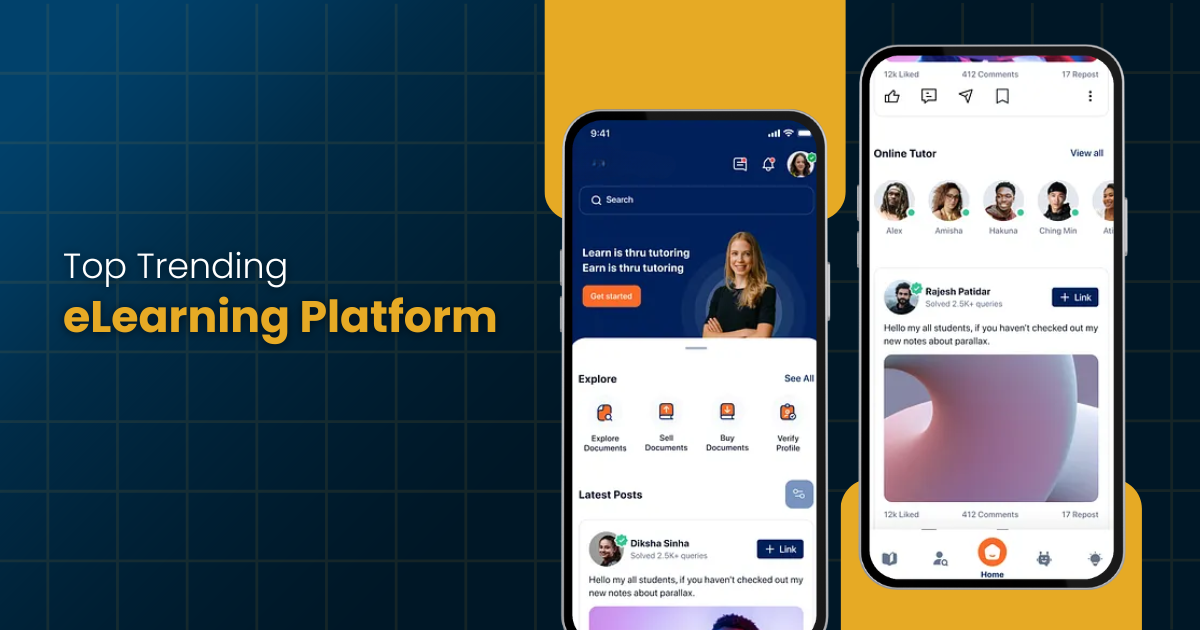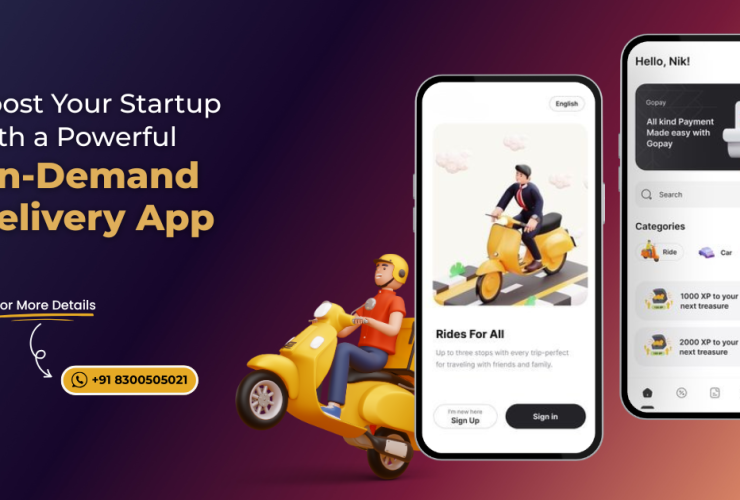The eLearning sector has changed the way people gain knowledge and skills. From corporate training to school classrooms, and from professional certifications to hobby learning, online platforms have become the new normal. According to recent studies, the global eLearning market is expected to exceed $400 billion by 2030, driven by the increasing demand for flexible, affordable, and accessible education.
If you’ve been considering building your own eLearning platform, now is the perfect time. Whether your goal is to create a niche learning hub, a large-scale education marketplace, or a corporate training portal, this guide will walk you through every step of the journey.
In this blog, we’ll cover everything you need to know about launching an eLearning platform: the concept, features, business models, development process, technology stack, benefits, challenges, and tips for success.
What is an eLearning Platform?
An eLearning platform is an online space where learners and educators interact digitally. These platforms allow users to access educational content anytime, anywhere, through videos, quizzes, live classes, and community features.
They can serve multiple purposes, including:
🔹 Online Course Marketplaces (connecting learners and instructors globally)
🔹 Corporate Training Platforms (helping companies train employees remotely)
🔹 School/College Learning Systems (digital classrooms and blended learning)
🔹 Niche Platforms (focused on specific skills like coding, fitness, or design)
Why Launch an eLearning Platform in 2025?
🔸 Rising Demand for Online Education – Students and professionals are actively seeking digital learning alternatives.
🔸 Global Accessibility – Learners from different regions can access the same content.
🔸 Scalability – A well-built platform can host millions of learners simultaneously.
🔸 Revenue Opportunities – Monetization options include subscriptions, course sales, ads, and certification fees.
🔸 EdTech Boom – Investors are heavily funding innovative eLearning startups, making this a lucrative sector.
Business Models for eLearning Platforms
Before starting, decide how you want to monetize your platform. Common business models include:
💰 Subscription-Based Model – Users pay monthly/annual fees for unlimited access.
💰 Pay-Per-Course Model – Learners purchase individual courses.
💰 Freemium Model – Offer free basic content, with paid premium content.
💰 Corporate Licensing – Companies buy packages for training employees.
💰 Advertising & Sponsorships – Monetize with ads or sponsored content.
💰 Certification Fees – Charge learners for official certificates after completing courses.

Top Trending eLearning Platform
Building an eLearning platform from scratch can be time-consuming and expensive. This is where clone scripts like Udemy Clone and Unacademy Clone come into play. They provide ready-made frameworks with pre-built features, allowing entrepreneurs to launch their platforms quickly and cost-effectively.
What is a Udemy Clone?
A Udemy Clone is a ready-made e-learning solution that replicates the core functionalities of Udemy. It is designed for entrepreneurs who want to create an online course marketplace where multiple instructors can publish courses and students can enroll, learn, and earn certifications.
Key Features of Udemy Clone:
➡️ Course marketplace with unlimited instructors and learners
➡️ Video-based learning with quizzes and assignments
➡️ Ratings, reviews, and feedback system
➡️ Multi-language and multi-currency support
➡️ Secure payment integration and instructor payouts
➡️ Certificate generation for learners
This model is ideal if you want to create a large-scale course marketplace with a wide range of subjects and a global audience.
What is an Unacademy Clone?
An Unacademy Clone is another powerful solution that focuses more on live learning and test preparation, particularly for competitive exams. It enables educators to conduct live sessions, create structured learning programs, and engage directly with students.
Key Features of Unacademy Clone:
➡️ Live and recorded classes
➡️ Doubt-clearing sessions and real-time chat
➡️ Subscription-based access to multiple courses
➡️ Interactive quizzes and mock tests
➡️ Teacher dashboards with analytics and performance tracking
➡️ Student progress tracking and personalized recommendations
This model is best suited if you’re targeting exam preparation, structured learning programs, or subscription-based education models.
Why Choose a Clone Script for Your eLearning Platform?
✅ Faster Launch – Save months of development time.
✅ Cost-Effective – Avoid huge upfront costs of building from scratch.
✅ Proven Business Model – Successful eLearning giants inspire clone scripts.
✅ Customizable – Add features, branding, and integrations to suit your vision.
✅ Scalable – Start small and expand as your learner base grows.
With Udemy Clone and Unacademy Clone, you can leverage tried-and-tested business models while customizing the platform to align with your niche and audience.
Standards Key Features of a Successful eLearning Platform
1. For Learners
• Easy sign-up & profile management
• Advanced search & filtering of courses
• Video lectures, PDFs, quizzes, and assignments
• Progress tracking & gamification
• Discussion forums and community support
• Multi-device access (web & mobile apps)
• Certificates and achievement badges
2. For Instructors
• User-friendly course creation tools
• Video upload & editing options
• Quiz & assessment builder
• Real-time analytics on student performance
• Earnings dashboard
• Live class integration
3. For Admins
• Dashboard to manage users, courses, and revenue
• Payment gateway management
• Content moderation
• Reports & analytics
• Marketing and promotions control
• Security and compliance tools
Step-by-Step Guide to Launching Your eLearning Platform
Step 1: Define Your Niche
Identify your target audience and the subject area. Are you focusing on tech skills, K-12 education, corporate training, or wellness? A clear niche increases your chance of success.
Step 2: Select a Business Model
Decide whether you’ll run a subscription-based platform, a marketplace for multiple instructors, or a single-instructor brand.
Step 3: Conduct Market Research
Analyze competitors, understand learners’ needs, and identify gaps you can fill.
Step 4: Plan Your Features
List down must-have features based on your business model. Start with core functionalities and add advanced features later.
Step 5: Choose the Right Technology
Choose the advanced technologies that are suitable for your business needs. Our development team will guide you through every step to successfully launch your eLearning platform and achieve your dream project at an affordable cost.
Step 6: Development Options
‣ Custom Development: Build from scratch for full control.
‣ Clone Scripts & Ready-Made Solutions: Faster and more cost-effective to launch.
‣ No-Code Platforms: Ideal for MVPs and small-scale projects.
Step 7: Content Creation & Partnerships
Collaborate with instructors, institutions, or in-house educators to build high-quality courses.
Step 8: Testing & Quality Assurance
Ensure smooth navigation, error-free video playback, and secure payment transactions.
Step 9: Launch & Marketing
Use digital marketing strategies such as SEO, social media ads, influencer marketing, and email campaigns to attract learners and instructors.
Step 10: Scaling & Continuous Improvement
Gather feedback, add new features, expand content, and improve user experience regularly.
Benefits of Launching Your Own eLearning Platform
‣ Global Reach – Break geographical barriers.
‣ Flexible Learning – Learners study anytime, anywhere.
‣ High Revenue Potential – Multiple income streams.
‣ Scalability – Easily expand your platform as demand grows.
‣ Brand Authority – Build trust as a leader in online education.
‣ Data Insights – Track learner behavior for better decision-making.
Challenges & How to Overcome Them
📌 High Competition – Differentiate with niche content or superior UX.
📌 Content Quality – Work with expert instructors.
📌 Technology Costs – Use scalable and affordable hosting solutions.
📌 User Retention – Gamify learning, offer certifications, and engage communities.
📌 Monetization – Test multiple models to see what works best for your audience.
Marketing Strategies for eLearning Platforms
✔️ SEO Optimization – Rank higher for keywords like “online courses” and “eLearning platform.”
✔️ Social Media Marketing – Use platforms like Instagram, LinkedIn, and YouTube.
✔️ Email Campaigns – Keep learners engaged with newsletters and course updates.
✔️ Referral Programs – Encourage learners to invite friends.
✔️ Influencer Partnerships – Collaborate with educators and professionals.
✔️ Freemium Offers – Attract users with free trial content.
Future Trends in eLearning (2025 & Beyond)
💡 AI-Powered Learning – Personalized learning paths with AI tutors.
💡 AR & VR Integration – Immersive learning experiences.
💡 Gamification – Turning learning into an engaging game-like journey.
💡 Microlearning – Short, focused lessons for busy learners.
💡 Blockchain Certificates – Secure and verifiable credentials.
💡 Multilingual Platforms – Catering to global learners.
Conclusion
Launching your own eLearning platform is not just a business opportunity—it’s a chance to shape the future of education. By combining the right business model, technology stack, features, and marketing strategies, you can create a platform that empowers learners worldwide.
The demand for digital education is at an all-time high, and with innovations like AI, gamification, and AR/VR, the possibilities are endless. Whether you aim to build a niche learning community or a global marketplace, the key lies in delivering high-quality content, seamless user experience, and consistent value.
Now is the ideal time to enter the thriving EdTech industry. With the right approach, your eLearning platform could become the next big name in online education.





